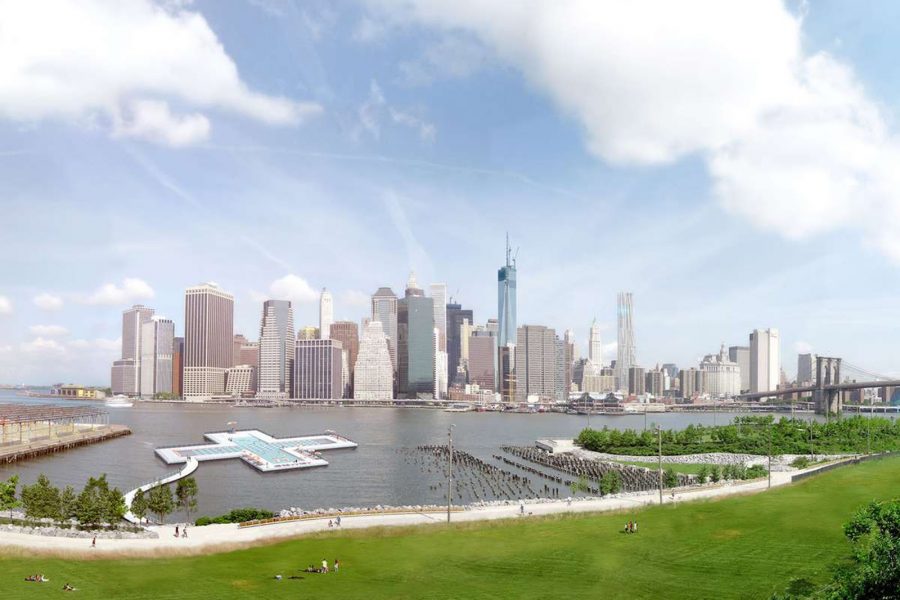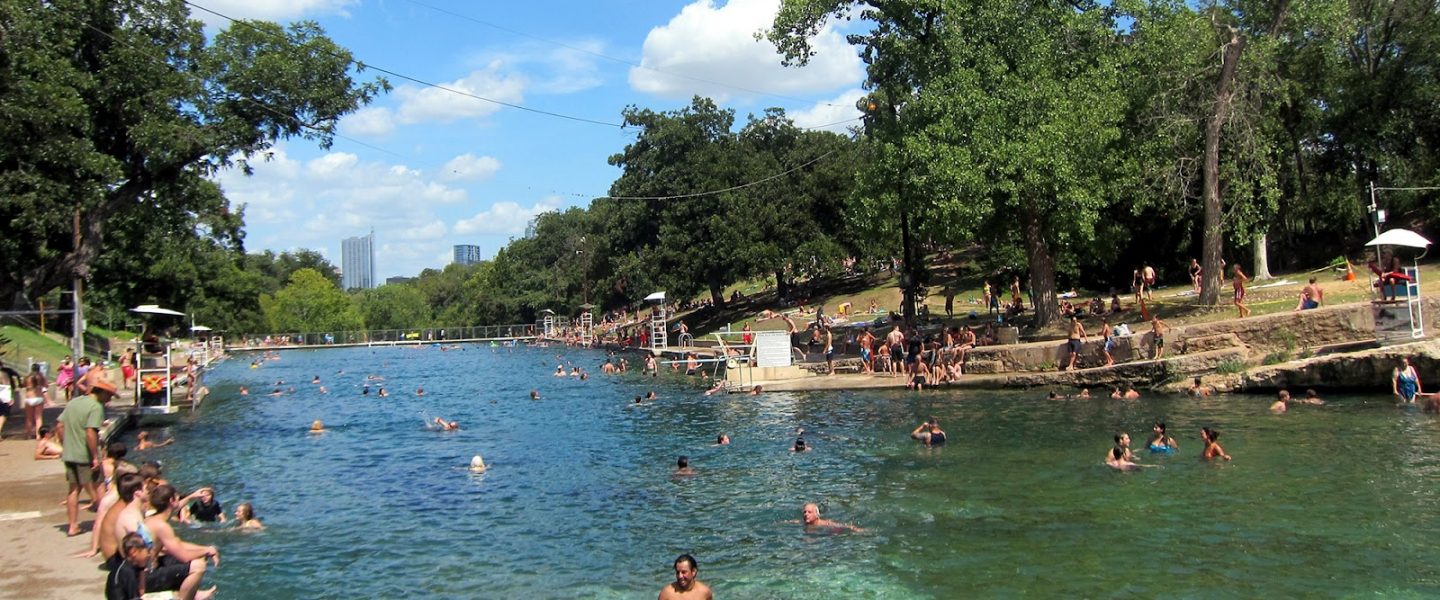Swimmable Cities Are a Climate Solution
Amid scorching heat, cities around the world are rethinking access to waterways.
|
Listen To This Story
|
As recently as the 1940s, New Yorkers swam in floating pools in the Hudson and East Rivers. A safer alternative to swimming directly in the river, the municipal baths kept residents cool in hot summer months until they were closed over sanitation concerns.
Now, as the city contends with life-threatening heat, can New Yorkers once again turn to the rivers to stay cool?
The team behind +POOL, an initiative to bring a floating swimming pool to the East River, is betting on it. The organization’s proposed cross-shaped, Olympic-size pool would differ from its historic predecessors in one significant way: filtration. One million gallons of filtered East River water would flow through the pool daily — offering a new, supervised space for New Yorkers to escape the heat. The project was first proposed in 2010, but increasingly frequent heat waves, a result of climate change, have given the project new urgency, its supporters say.
New York has the highest urban heat island (UHI) index in the country. On average, its urban heat islands are 9.5 degrees hotter than surrounding areas. Low-income communities of color are disproportionately impacted by extreme heat — a legacy of racist redlining policies that have saddled neighborhoods with fewer green spaces and more heat-trapping asphalt and concrete. And many of these communities lack access to safe swimming spaces.
“The increased instances of extreme heat are only making public [swimming] access more desirable,” said Kara Meyer, managing director of +POOL. Cleanups, new filtration technologies, and sophisticated water-quality monitoring could make river swimming once again an appealing, and safe, option.

A Global Trend
It’s not just New Yorkers who are rethinking their relationship with their waterways. With heat waves increasing in frequency, intensity, and duration because of climate change, a growing number of cities are opening rivers and lakes to swimming.
River swimming is a popular pastime in European cities like Copenhagen, Berlin, Zurich, Munich, and Vienna. Paris is spending $1.5 billion to clean up the Seine and open it to swimmers ahead of the 2024 Olympic Games.
Cities like Boston, Chicago, Washington, DC, and Portland, OR, have either opened their rivers to swimmers or announced plans to build swimming infrastructure.
“As a climate solution, being able to swim in your local waters just seems like a no-brainer,” said Jake Madelone, senior waterfront education coordinator at Waterfront Alliance, a group that advocates for making New York’s 520-mile shoreline more accessible and resilient to climate change.
Urban waters across the US have undergone major cleanups since the passage of the Clean Water Act a half-century ago. The East and Hudson Rivers are significantly cleaner now than in the past, thanks in large part to investments in the city’s sewage treatment facilities. (The East River is actually a saltwater tidal estuary.) Competitive swimmers already race in the waters, although many sites still do not meet Environmental Protection Agency standards for swimming.
“The cities that are really embracing urban river swimming have done massive cleanups,” said Meyer. Copenhagen modernized its sewer and wastewater treatment systems in the early 2000s and has since added public baths and a mobile dipping zone to its harbor. Boston is separating some combined sewers, which carry sewage and stormwater, to limit overflow of untreated combined sewer overflows, or CSOs, into its harbor.
But there are other ways to provide access to waterways while those cleanups are underway. Paris officials have said they plan to use machine learning to forecast contamination in the Seine and deliver mobile alerts to swimmers. The Floating Lady, a chlorinated, mobile floating pool on a barge, already docks in the Bronx.
Building Safer Connections to the Water
Urban waterways are a crucial climate solution — but they’re not equally accessible to all communities. Black Americans are less likely to know how to swim and are more likely to drown than white Americans, a disparity that can be traced back to segregation. Many cities drained and shuttered public pools to avoid allowing in Black swimmers — or lacked resources to maintain public pools when white people fled to the suburbs.
Urban public recreational spaces, including waterfronts and waterways, “have historically, in many ways, been exclusionary,” said Vivek Shandas, a Portland State University professor who studies urban climate adaptation. Any plan to open up new swimming spaces needs to redress that, he said. “Welcoming people into these outdoor swimmable spaces is really important,” Shandas said. “Being explicit about [their] belonging has to go hand-in-hand with any physical change of the environment.”
For many Americans, swimming lessons are too expensive, inaccessible, or unwelcoming. Lifeguards often teach swimming, but the nationwide lifeguard shortage — due to declining pay and a lack of training opportunities — means even fewer lessons are available. In New York, the city’s 48 outdoor public pools were operating at limited capacity due to lifeguard shortages.
Volunteers with +POOL have been providing free swimming lessons at pools around the city since 2015, and the organization is creating a lifeguarding workforce development program with Henry Street Settlement, a local nonprofit. “It’s not equitable access to the river if people don’t know how to swim or don’t have the opportunity to learn,” Meyer said.
Advocates like Meyer may have the political support they need to get more New Yorkers in the water. In 2021, the city’s planning department released a 10-year comprehensive waterfront plan that aims to “promote opportunities to get onto and into the water.” The plan proposes floating river pools in addition to longer-term investments in improving water quality and coastline infrastructure.
Mayor Eric Adams has spoken out in support of +POOL, and there are currently three bills before the City Council that would increase access to free swimming lessons, build new swimming pools in environmental justice communities, and address the lifeguard shortage.
If +POOL has its way, some of the barriers between communities and their surrounding waterways could soon disappear. “We should be able to enjoy our natural environment, particularly in New York, where we have this resource all around us,” Meyer said. “There’s so much opportunity for the taking. We just need to design specific, safe access points.”
This story by Sarah Amandolare was originally published by Nexus Media News and is part of Covering Climate Now, a global journalism collaboration strengthening coverage of the climate story.





